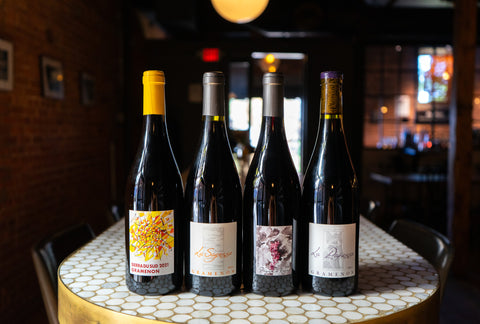Have you tasted Gramenon’s Poignée de Raisins? If you’re not expecting it, this joyous, fruit-driven Grenache will absolutely deck you with its delirious aromatics and hidden complexity. It’s ethereal, but still full of the earthy, herbaceous, rich fruit characteristics that make Grenache from this part of the world so lustworthy. You wouldn’t be the first to get knocked off your feet.
Gramenon has been taking names since its first vintage in 1990. Back then, it was Philippe Aubéry-Laurent at the helm of the Southern Rhône estate, while his wife Michèle worked as a nurse. Philippe was an early adherent to natural winemaking principles: organic and biodynamic practices in the vineyard, native yeast in the cellar, no fining or filtration, and minimal (if any) doses of sulfur at bottling.
From Early National Recognition to Cult Status
In 1990s Paris, he didn’t go unnoticed. Along with other natural-leaning winemakers, Philippe’s wines were featured on the lists of hot spot wine bars catering to everyday Parisians and wine nerds alike. Elsewhere in the world? Forget it — wine like this, however true to traditional, pre-industrial winemaking, was subversive. Here in the U.S., we were in the grips of our Merlot obsession and Kermit Lynch was still attempting to persuade shoppers of the merits of traditionally crafted wines.
Even if the rest of the world hadn’t caught up yet, by the end of the 1990s, the name Gramenon meant something. Phillipe’s hard work was paying off. But then, in 1999, the winemaker died in a tragic accident. His wife Michèle was left with their three children, their vineyards, and the winery. She could have given it up. Sold the land or rented the vines. Instead, she stepped into Phillipe’s shoes and committed herself entirely to fulfilling his vision.
To say she succeeded would be an understatement. Over the last 20-odd years, Michèle has grown Gramenon into the cult phenomenon that it is today. She pursued organic and biodynamic certifications and has brought her own creative touch to the limited productions of primarily old-vine Grenache. More recently, she was joined by her son Maxime François, a rising star in his own right who bottles a handful of cuvées under his own name.
A Unique Terroir
Gramenon traffics in Côtes du Rhône. Brilliant, manifold, luscious Côtes du Rhône of varying cépages. At least half are entirely old-vine Grenache, their specialty. Others a more traditional blend of Grenache, Syrah, Mourvèdre, or Cinsault.
The estate lies at the far northeastern edge of the Southern Rhône, where the sizzling Mediterranean summers begins to give way to the more brisk conditions of the Northern Rhône. The fierce Mistral wind rushes through their old vines, most around 30 years of age and many close to 100. They’re tended rigorously by Michèle, Maxime, and the goats, chickens, and other animals the family raises on their estate.
Walking through the vineyards, you would think you’ve landed on some distant alien moon. Beneath the gnarled ancient vines are gleaming galets roulés— like moon rocks — that push their way out of the clay and limestone soils. In each layer of the ancient terrain, you can find remnants of long-lost seas, of mountain peaks thrusting toward the sun and collapsing, of rivers depositing their treasures as they wound their way through an evolving landscape.
Translation to Bottle
Gramenon’s goal has always been to translate that impressive landscape, and their uniquely adapted old vines, from vineyard to bottle. To let nothing stand in between the vivid transmissions radiate out of this remarkable place. In the winery, they opt for old-school gravity-fed tanks for a gentle approach. They age in demi muide or foudre depending on the cuvée. They always ferment with native yeast, and only use sulfur at bottling, when necessary.
The Wines
At last count, Gramenon creates almost 20 cuvées each year. Their Sierra de Sud cuvée is 100% Syrah — an anomaly for this Grenache-focused domaine. It’s partially destemmed and macerated for 12 days in cement tanks, then spends 7 months aging in tank and barrique before bottling. Soft and spicy, it benefits from the slightly northerly latitude and closeness to the northern Rhône.
Their Poignée de Raisins, a perennial favorite and incredible entry point for newcomers to the domaine, is 100% Grenache. Grapes are partially destemmed and spend 15 days macerating in cement tank, then ages 6 months in tank before bottling. This is pure, sunny, fruit-driven juice that doesn’t sacrifice an ounce of complexity. If you’re not expecting it, that sheer joyous energy will absolutely clothesline you.
If you aren’t already head over heels for Gramenon, consider this your invitation. A world with these wines is unquestionably a better one. Their small, devoted legion of fans around the globe will second that. If you see these wines on shelves, don’t hesitate. They rarely last long.



